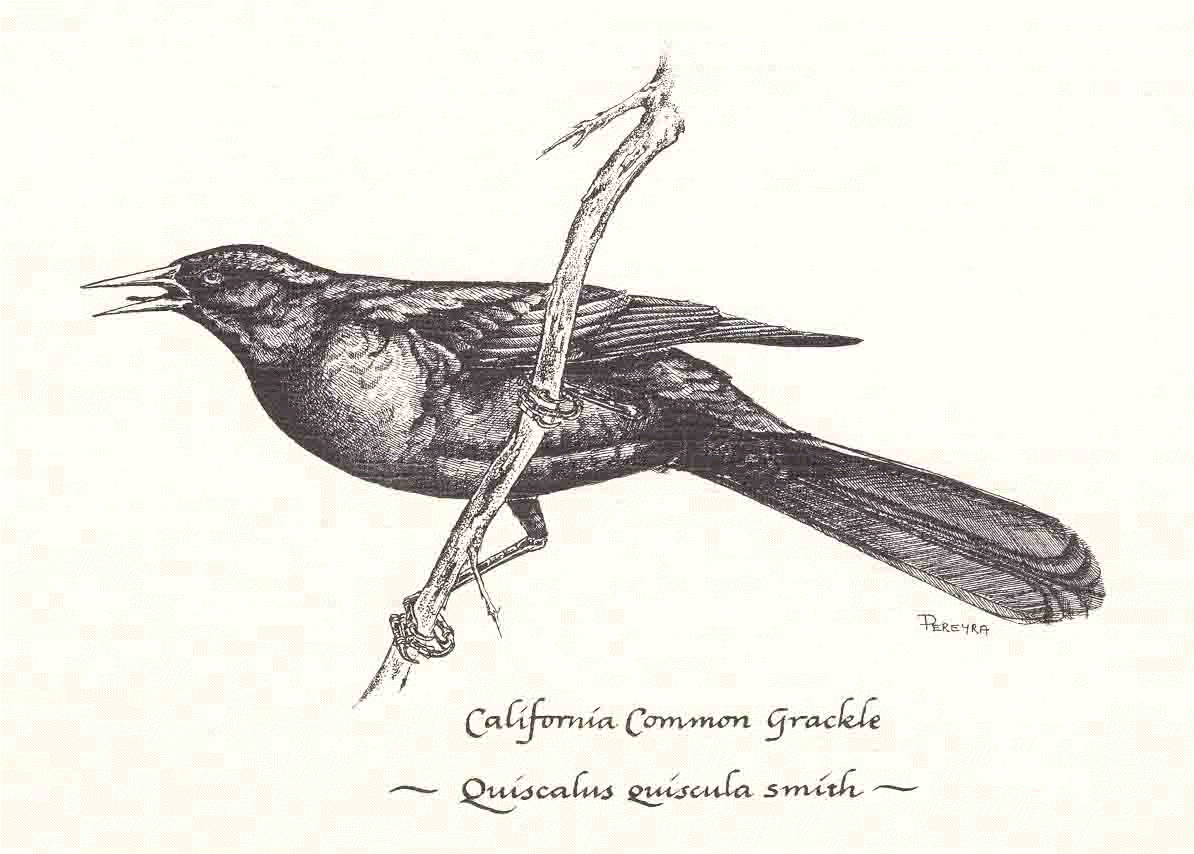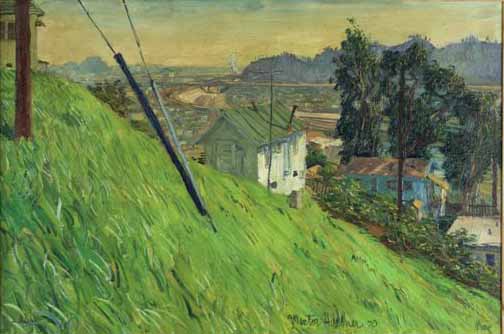
Art From Jack & Denny's House on Mt. Washington
“A book burrows into your life in a very profound way because the experience of reading is not passive.” Erica Jong, O Magazine, 2003
|
|
|
|
Historic Los Angeles
Jack and Denny had many works by local artists depicting scenes of early Los Angeles. Most notably, they had several prints by Carla Fallberg. In addition to her work on Los Angeles subjects, she has worked extensively in the film industry as an animation sculptor.
Mentor Huebner, American
Jack and Denny had one painting by Mentor Huebner in their home. It is oil on canvas and depicts a scene on the south side of Mt. Washington looking south toward the Los Angeles River, Elysian Park, and the old Taylor Railroad switching yard.
The following is the biography of Mentor Huebner that Louise Huebner has posted on the Mentor Huebner web site (www.MentorHuebnerArt.com).
Mentor Huebner was born July 19, 1917, in a little turn of the century house in East LA, in a section known as Boyle Heights, and was delivered by a professional Midwife ~ his own Grandma Huebner.
Although he was a second born son, he'd been given his father's first name, much to the chagrin of his older brother, who never forgave him for being the "Mentor II", nor for being a talented painter nor for having spent his entire adult life working in the motion picture industry, which his older brother felt was in someway connected with Mentor's distinctive name.
When Mentor II was ten years old, "Mentor I", died from tuberculosis (which had run rampant in the late 1920's). He was only 33. He had spent his tragically short adult life as a chauffeur and mechanic ~ and not as an artist of fine arts or a designer in the film industry. (If the older brother's theory was correct, Destiny made a mistake.) Another 'mistake' occurred when Mentor's Dad's rich ''Boss' tipped him with a chunk of land, which he promptly sold for $200.00. It was Signal Hill.
Still this fact did not dissuade "son number one" from his belief that he had not only been cheated out of his father's first name, but also out of everything that he believed would have accompanied it: the mystical 'birthright' of fame, fortune, notoriety and at least one beautiful wife, all of which supposedly went along with the name
'Mentor' has now become a family name, but it had not been at the start. Grandma Huebner, was responsible for starting the Mentor Dynasty. Impressed with the Latin name, after she discovered it in a history book. She was the one who had gotten the name going.
At this time there are two other additional Mentors; our first first born son, "Mentor III" and his son, "Mentor IV". "Mentor IV" promises there will, in the future, be a "Mentor V" , "For sure Grandma, I promise. I swear".
***
After, Mentor's poor, young Dad died of tuberculosis, it was necessary for his mother to work in order to support the two brothers.
Since she had no particular training, her brother-in-law, Dr. Frank McCoy, a famous medical nutritionist and radio personality gave her a job in his office, four hours a night, filing the day's paper work and Mentor, ten years old at the time, accompanied her.
McCoy's office was well stocked with what seemed to Mentor to be a gift from God, a treasure chest filled with an abundance of pads of paper, pens and pencils.
Mentor would settle down quietly in the patient's waiting room, and spend the hours 'drawing'.
Actually, that period of time, at McCoy's, was not the beginning of Mentor's creativity. When his Dad had first become ill, his Swedish, maternal grandmother, who had a chicken ranch out in the desert, kept little Mentor for entire summers.
Between chasing chickens, patrolling the acreage with his kid uncle Ernie, and looking at 'pictures' in comic books, Mentor spent his time drawing.
He often sent letters home to his mother, with drawings interspersed between childish scrawls and misspelled words. So it seems he had begun to draw in earnest when he was around eight years of age.
Mentor's mother attributed his ability to the fact that when she was pregnant with Mentor she had frequented many Los Angeles art galleries and museums.
"That's what did it." She bragged throughout his life. As the only connection with art on either side of the family had been those museums. What else could it be?
Uncle Ernie of course believed it had been the exposure to his collection of comic books. "That helped!"
Mentor's irate brother insisted, "He's a show-off..."
"Mentor's a good boy" said Grandma. "He's going to be an artist". And indeed that's what he did do. He became an artist. Grandma was right.
***
Mentor's family's ethnic background was a mixture of several European nationalities. His mother's family - she always lectured, was 'pure' Swedish. My mother-in-law prided herself on being a 'blue eyed blond' due to that bit of chance 'luck'. But I've seen quite a few dark Swedes. Very dark. In fact they are called Black Swedes! She though -- always reassured me -- wasn't one of them!
Mentor's father's family was from Austria Hungary and mostly of German heritage. However, Grandma Huebner's family carried a spec of Russian and Polish. She was definitely not a 'blue eyed blond' and was often mistaken for a Gypsy.
My mother-in-law as destiny would have it was cruelly placed between the bookends of a mother-in-law and daughter-in-law who shared the distinction of being "The Huebner Gypsies".
Mentor had greenish hazel eye coloring and although he had been a platinum blond from childhood up through elementary school, his hair darkened to a golden ash brown as he reached adulthood.
Until I saw him naked I was under the impression he was dark skinned. However, since he was a 'plein aire painter' and worked outdoors constantly ~ painting landscapes and seascapes and cityscapes ~ he was always darker and a kind of golden brown.
He tanned quickly. So much so that during the Algerian Revolution while we were on location in France for the film The Longest Day, he was frequently stopped by the military police as a suspect of terrorist activities.
Sometimes this would happen as he left the Bank of America in downtown Paris. Or while shopping for veggies at an open air market not far from our apartment in Saint Cloud.
But come to think of it he was also, often pulled over in Los Angeles, California, at Los Felix and Riverside Drive, as he drove past the Fountain, because he looked 'suspicious'.
He never crossed any border easily.
Traveling by car throughout Europe loaded with our three kids, baby paraphernalia, luggage for all, along with three trunks (on top of the car), painting supplies, and sixty pound cans of French SMA Baby Formula -- without an inch to spare anywhere in the car and with no air pockets -- we would be stopped at each border and asked to unload for 'inspection'.
Time and time again I would be forced to use my charms to get us past the Border Patrol.
As I worked my potentials, the Guards would "Senora" me this and "Senora" me that, stare directly into my eyes, admire 'my' twins, comment on the politeness of the "good big brother", while one or the other would take turns to glare at Mentor!
I don't know to this day what caused all that.
I guess Mentor had vibes.
I thought he was sexy.
But, the Border Patrols must have seen things differently.
Them, and the Cops on Riverside Drive.
Arthur H. Millier, English (migrated to America in 1908), Somerset, England, 1893 - Los Angeles, CA, 1975
Arthur Millier: An influential California etcher, painter and arts writer, Arthur Millier moved from England to Los Angeles in 1908. His first artistic training took place at the Art Students League, Los Angeles. He then served with the American Army in France during World War One. At the end of the war (1918) Millier completed his studies at the California School of Fine Arts, San Francisco.
Arthur Millier returned to Los Angeles in 1922. During the following years he taught art and etching techniques at such institutions as the Chouinard School, the Otis Art Institute, University of Southern California and the Pasadena Art Institute. Millier also was the long time art editor and critic for the Los Angeles Times. From this important position Millier was among the first to promote the growth of regional California art. His association with the California Scene Painters (also called the 'California Group') helped to establish the national reputations of such California artists as Emil Kosa, Phil Dike, Millard Sheets, Barse Miller and Rex Brandt.
Arthur Millier's first etchings and drypoints date from around 1920. They depict the back streets and the poor peoples of San Francisco. Within several years, however, he had turned primarily to the stately California landscape etchings and engravings for which he is now most highly regarded. Such fine work gained him prizes from the California Society of Etchers in both 1922 and 1928.
Arthur H. Millier was a full member of the Chicago Society of Etchers, California Society of Etchers, Print Makers' Society of California and the California Art Club. Today his prints are included in the permanent collections of such major institutions as the Los Angeles County Museum and the Art Institute of Chicago.
Source: www.artoftheprint.com
|
|
||||||
|
|
|
||||||
Sueo Serisawa, American, 1910 - 2004
|
|
|
||||||
|
|
|
||||||
William P. Wallett
Bill and his wife Agusta Wallett lived accross the canyon from the Smith house for many years and he gave these to paintings to Jack and Denny.
|
Bill was born in Milwaukee, WI on May 13, 1907. Wallett spent his childhood in Pasadena. He studied architecture at USC while receiving art instruction from Dan Lutz and Paul Sample. Prior to WWII he worked in the art departments of Universal and Disney Studios. His paintings often depict urban scenes, junk yards, and amusement parks in a fantasy motif. He died in Los Angeles on April 10, 1987. Exh: Santa Cruz Art League, 1934, 1938; Painters & Sculptors of LA, 1934-36; Calif. WC Society, 1935-1955; Calif. State Fair, 1936; GGIE, 1939. |
| Source: www.askart.com Edan Hughes, "Artists in California, 1786-1940" Southern California Artists (Nancy Moure). |
|
|
||||||
|
|
|
||||||
















